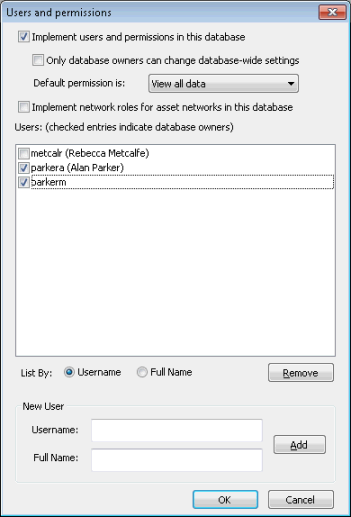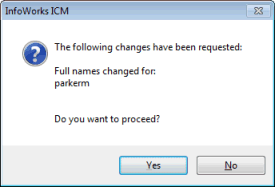This dialog is used to:
- Turn user permissions on or off for the current on-premise database
- Turn protection of global settings on or off for the current on-premise database
- Set the default restriction on viewing data for all Database Users
- Add Database Users and Database Owners to the current on-premise database. Users must be added as Database Users before they can be made Database Owners or Asset Group Owners
The dialog is displayed when Database management Users and permissions is selected from the File menu. The menu item will be disabled if you are not a
Database Owner for the current database.
Users and permissions is selected from the File menu. The menu item will be disabled if you are not a
Database Owner for the current database.
Information about the current on-premise database is recorded in the registry. This information is retained between InfoAsset Manager sessions, so you continue working with the same database next time you start InfoAsset Manager. The registry information is only changed when you open a different on-premise database.
You can run more than one instance of InfoAsset Manager on the same machine, but all of the instances must be using the same database. If you try to work with two databases at once the registry keys will become confused and you will have problems in several areas like running simulations. The simulation engine is a separate program that looks in the registry to find information about the current database.
Details of the current database can be found in the InfoAsset Manager About Box.

Users and Permissions Dialog
Dialog description
Implement users and permissions in this database - check this option to activate user permissions to restrict editing of specific network groups to specific users. Only a Database Owner can turn user permissions on or off.
Only database owners can change database-wide settings - check this option to restrict editing of global settings to Database Owners. Only a Database Owner can turn protection of global settings on or off. This option is only enabled if user permissions are turned on.
Default permission is: - sets the default permission for all objects in the database for Database Users that do not have specific roles specified. The options are:
- View all data - the user can open objects but has read-only access.
- View group data - the user can see objects in the tree but cannot open them. Only the properties of the objects can be viewed.
Managing users
- To add a new Database User, type the name of the user in the Username: box of the New User area and click the Add button. InfoAsset Manager uses login names to identify users, so the name must match the username for the computer or network.
- To remove a Database User, highlight the name in the Users: list and click Remove.
- To add or remove Database Owner privileges, check or uncheck the tick box next to the user's name.
It is possible to add a Windows group as a Database User. Users who are members of such a Windows groups will automatically inherit the roles assigned to the group for relevant groups in the tree, in addition to the roles assigned specifically for the user.
- To add a Windows group as a Database User, type the group name within square brackets e.g. [User-Group-1]
- All users and groups must be in the same domain, which is the domain of the computer
When you click OK in the Users and Permissions dialog, you are prompted to confirm the changes you have requested. The confirmation dialog lists all the users affected, and the changes for each of those users.

Confirmation Dialog
Note about write permissions implemented on a per user basis
In addition to the global permissions above-described, database owners can also grant permissions on a per user basis, for the whole database or just a specific network. Users are assigned one or more network roles, and different permissions are associated with each role. These restrictions determine what a user can and cannot do at network object and/ or data field level.
See User Permissions for further details.